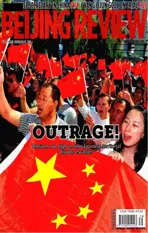MARKET WATCH
2012-12-21
MARKET WATCH
OPINION
Cap ita l Fligh t Becom es a Con ce rn
The renminbi counterpart of China’s foreign exchange reserves in August decreased by 17.4 billion yuan ($2.76 billion) compared to July. At the same time, the United States and the EU have started unlim ited bond buying.Should China worry about an influx or a fl ight of capital? In the future, how w ill the flow of short-term capital and long-term capital diverge?
In fact, capital flight has become one of China’s biggest short-term risks. Since the end of last year, foreign reserves have shrunk,the renm inbi counterpart of foreign reserves has dropped month by month, and monthly foreign direct investment (FDI) also continues its decline. All these indicate that cross-border capital is fleeing out of China. Statistics show that China’s monthly FDI has registered negative grow th since November 2011, except for a meager 0.05-percent grow th in May.
But now, the U.S. Federal Reserve’s third round of quantitative easing, known as QE3,may reverse short-term capital’s outflow,which has lasted for almost one year, into a new round of inflow. Most monetary capital,driven by interest, w ill flow to the commodity markets and emerging econom ies, where investment returns will be high. The possibility of a short-term capital backflow to China w ill increase, raising concerns about the pressure of a massive capital influx.
However, we should differentiate the capital com ing in and out of China. Is it short-term speculative capital or long-term industrial capital?
A lleviating EU sovereign debt crisis and the U.S. QE3 can make the global economy recover to a certain degree in 2013. But due to the prolonged sovereign debt crisis in developed countries, accelerated rebalancing of the global economy and the reduced investment returns in emerging markets, the longterm trend of capital inflow into emerging econom ies is facing a turning point. Longterm capital, especially industrial capital, w ill slacken its pace as it enters China.
From a m id- and long-term perspective,major factors that affect international capital flows are changing.
First, the sovereign debt crisis in developed countries is undergoing a prolonged“de-leveraging” process, which can lead to a backflow of their overseas capital. Second,the global aggregate demand dom inated by developed countries continues to shrink. The golden w indow of ultra-high speed grow th in Chinese exports has been closed. The efficiency of China’s labor-intensive exporting sectors has begun to decrease. Third, China,which has been depending on low prices to subsidize globalization dividends, is on the road to revaluing its production elements,which w ill certainly squeeze profit margins of FDI. Fourth, some capital may turn to developing countries w ith lower costs, eroding the amount that used to flow into traditional emerging markets like China. Fifth, the United States is pushing forward its “re-industrialization” strategy. The Obama administration aims to reshape the global industrial chain by w ithdraw ing industrial capital. W ith a strong return of “Made in USA,” the United States could become an FDI destination instead of a source of FDI, which w ill not only draw back U.S. capital but also attract global capital to its large and developed market. This w ill lead to a slowdown in FDI grow th worldw ide. In the future, w ith the changing pattern of global capital flow and the unfolding of industrial distribution, the slackening pace of global capital into China will become more evident.
What China should prevent is not only a massive flight of hot money, or speculative capital, but also the outflow of long-term capital.
The era in which China has relied on its cheap resources and fat profi ts to attract global capital is com ing to a close. To rebound,China should quickly increase its human capital, labor productivity and the capacity of the market. It should also introduce projects w ith advanced technology conducive to raising its competitiveness and create a fairer investment environment to foster new strengths in its economy.
THE MARKETS
Stee l Prices Dow n
China’s steel output saw a drop in August as prices of steel products have continued to fall,said the National Development and Reform Comm ission.
Crude steel production shed 1.7 percent year on year in August, contrasting w ith the 13.8-percent grow th recorded during the same period of last year.
In August, the composite price index for China’s domestic steel products averaged at 104.39 points, pulling back 7.64 points from the previous month and down 30.78 points from a year earlier.
In the fi rst eight months, China produced 481.57 m illion tons of crude steel, up 2.3 percent year on year. The grow th represented a retreat of 8.3 percentage points from the grow th seen a year earlier.
W and a’s Am b ition
At the 2012 Cultural and Creative Industry Summit in Beijing on September 19, Wang Jianlin, Chairman and President of Dalian Wanda Group, outlined his company’s ambitious plans to further develop China’s culture industry.
“Wanda Group w ill develop three cultural locations in Dalian of Liaoning Province,Beijing and Guangzhou o f Guangdong Province, w ith Dalian focusing on filmmaking and operations and Beijing on cultural travel, in hopes of garnering revenue of more than 80 billion yuan ($12.69 billion) in 2020,”Wang said.
The company began to invest in the culture industry in 2005 and its reach includes fi lm production and distribution, stage shows and entertainment chains.
It has become the world’s largest cinema operator after acquiring the world’s second largest cinema chain AMC Theater Co.
